You may not find this terribly rewarding unless you're included here, so this is a good time for casual and random browsers to turn back before they get too caught up in the sweep and majesty of the proceedings and can't let go.

Whenever the cat carrier comes out, Choupette is first in line. Melvin is instantly either under the bed or in the back of a closet, behind the coats.

Choupette can't wait to climb aboard.

Now Melvin's nicely kitted out for the trip, and Choupette's found another way to torment him. (Once on the road, Melvin invariably curls up in the wayback and sleeps for the duration, no matter how long the trip; Choupette invariably bounces around and squawks loudly, then after 20 minutes either goes to sleep on her minder's lap or continues squawking for the rest of the journey.)
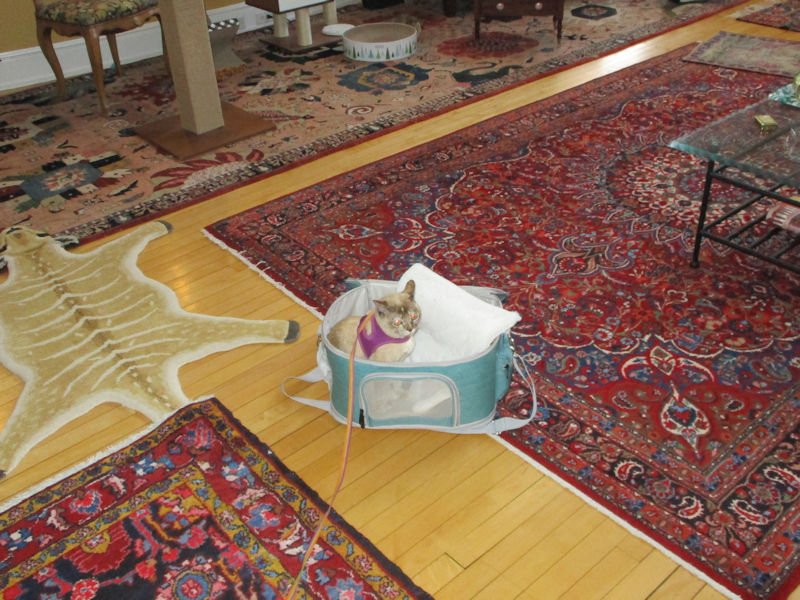
Okay, here we go. 27 February 2022.
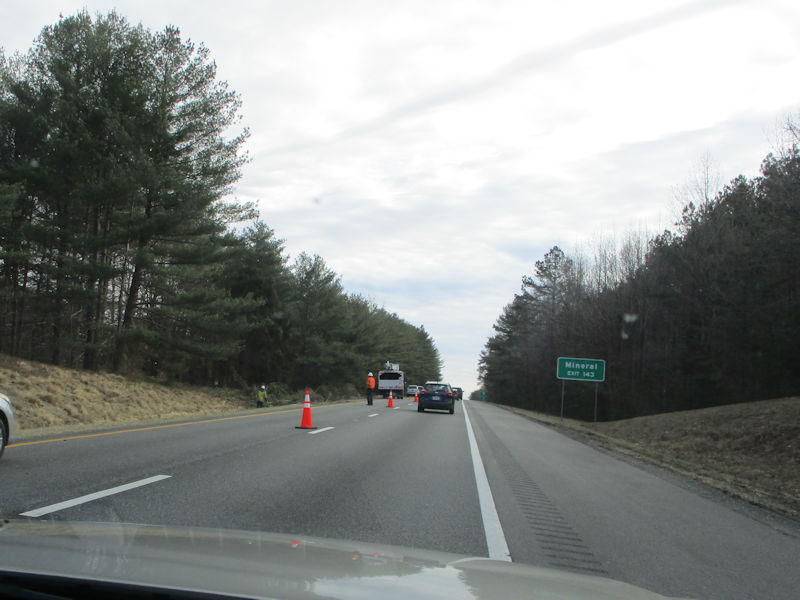
A catastrophic windstorm the previous night knocked quintillions of trees from the median onto I-64, for much of the road between Charlottesville and Richmond. The valiant services got all the trees off the roadway overnight and are presently cutting them up with giant machines and carting them off the battlefield.
So four times going east, as we are now, the road was down to single lane so that the chaps and their machines could carry on -- likewise on the westward lanes -- and we got to sit for a while as the lanes merged into one ahead of us. Often prolonged by the privileged citizens who careened past our waiting right lane at speed, blasted up to the front of the line in the left lane, then snarled and gesticulated angrily to be allowed to cut into the queue. Fellow citizens they are, too, and they even get to vote as we do.
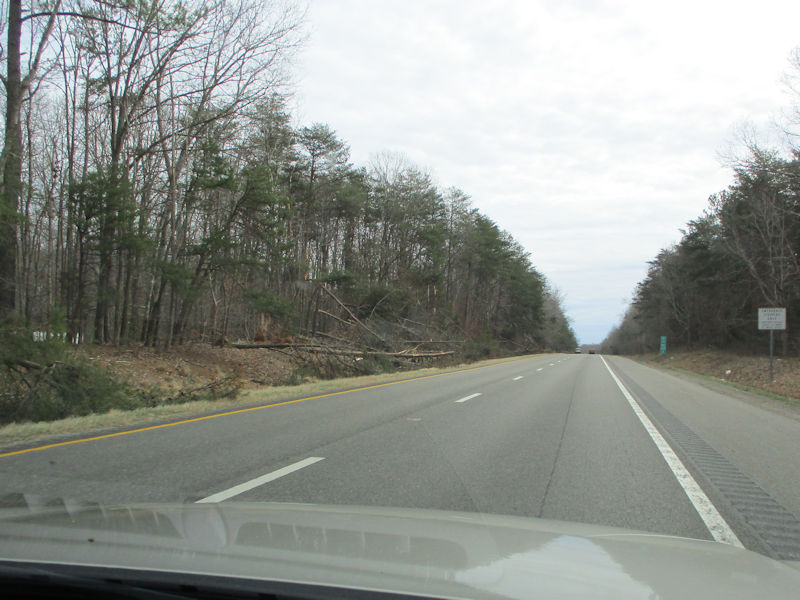
The traffic's blissfully sparse between the work zones, since everyone else is waiting on the merging lines elsewhere.
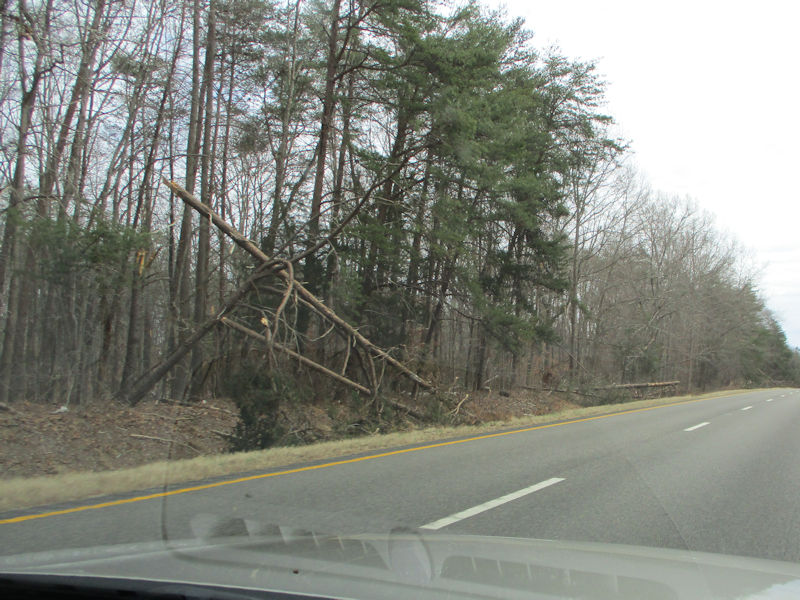
Of course, we're all thrilled not to have been driving on the I-64 when all this was going down.
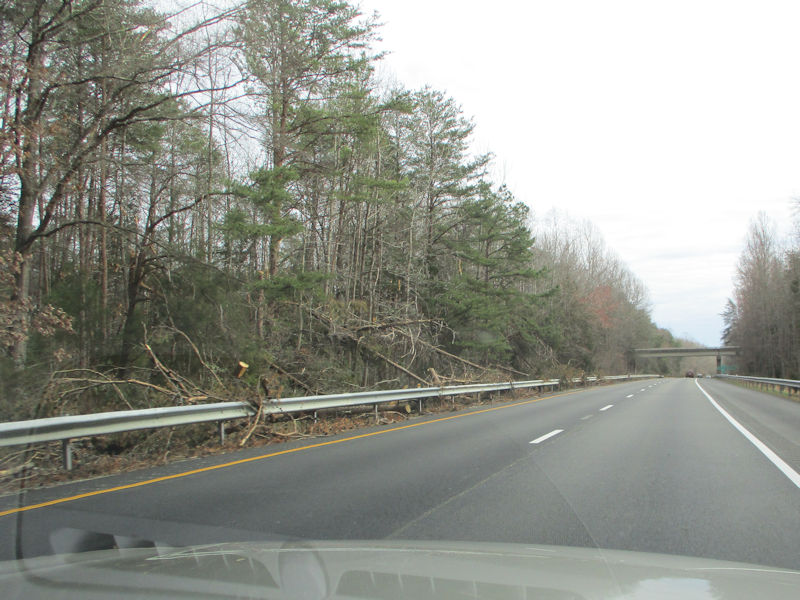
The service crews are heartily to be commended.

Despite our few inconveniences, our five-hour trip was not so very far off schedule at the end.

Roaring past the Virginia conurbations of Newport News and Norfolk, we're treated to this scenic tunnel-cum-bridge spanning the James River between them -- it's a clever idea, presumably to leave a span of surface water for shipping without having to haul a big drawbridge up and infuriate the tourists.

Once over this thing and through Norfolk itsownself, we cross over into the well-known state of North Carolina, into Currituck County in fact, and progress 40 miles down Rtes 168, then 158, through somewhat dilapidated countryside to the bridge over Currituck Sound to the town of Kitty Hawk.
Corolla, North Carolina

And from Kitty Hawk, back up north again on skinny Rte 12 (also called 'Duck Road'!, whilst Rte 158 bends off south and continues down to Cape Hatteras), through the town of Duck and eventually to the extremely attenuated town of Corolla, NC. That's our digs for the next week, described on Airbnb as ''Corolla Oceanside Hideaway, 5 min walk to beach', hosted by the helpful and friendly Michael Stuberg.

We're on the ground floor, facing out at the swimming pool (it's too unseasonal for putting in big pool-laps for our exercise, but perfect for tanning-whilst-reading of a sunny afternoon), and the family (wisely, in case of a storm surge) resides above.

Great wifi here, and a fine TV with all the streaming channels, though we never turned it on after this photo.

First things first -- feed the famished but patient cats.

Nice bedroom (the window's not worth opening; it reveals the front grille of our Volvo).

The cats are already settling in to the new digs.

A lame game of hide and seek
The town of Corolla (pronounded Co-RAH-lah; don't ask why) has a permanent population of ca. 500, with something like 47 million visitors in the summer, and all this despite the fact that it's not actually a town at all, it's an 'unincorporated community' that for long was inhabited by small groups living off of fishing, hunting, and salvaging shipwrecks [Wikipedia] and hired its first schoolteacher in 1905. It was for better or worse 'discovered' in the 1980s and exploded with beachside developments and lots of tourist infrastructure that was beginning to reopen for the season just as we were leaving.
Residents even succeeded in 1984 in getting a paved road (Rte 12) put in up from Kitty Hawk and Duck; prior to that they had to drive up the beach. Or walk, pulling a groceries cart.

Corolla (named for a post office that was put in in 1895) is about 11 miles long (and never has more than four streets, 600m, wide), with two modern 'shopping centre' open malls with restaurants, chain groceries and clothing stores, and a small 'historic' old town that we'll looking in on a few days hence.
We're here nearly at the end of the paved road, just north of 'downtown' Corolla, to visit this fine 600m boardwalk through 'maritime forests' out to the Currituck Sound, and back of course.
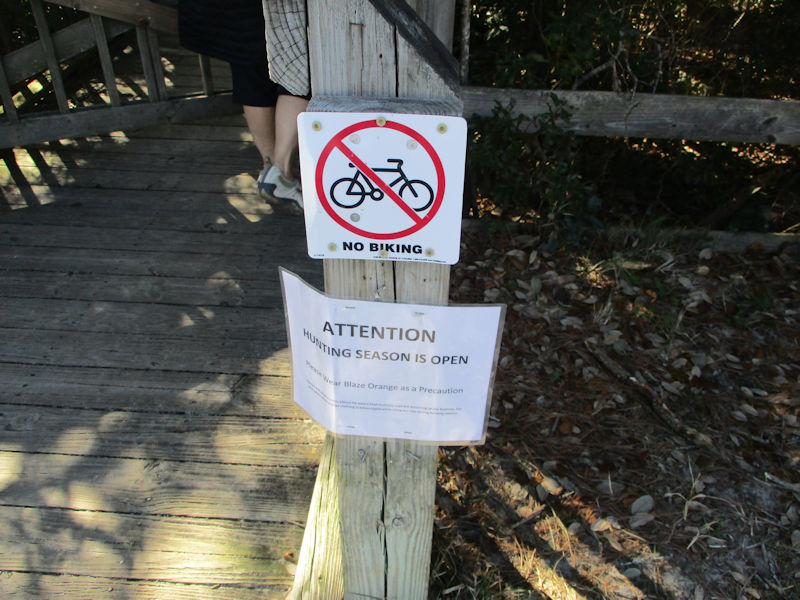
What!?! Wear Orange? This is a Nature Reserve!

A very good boardwalk, and there's often quite squishy ground alongside so it's a welcome amenity. We are falling in love with these horrifically disfigured trees all over the place.
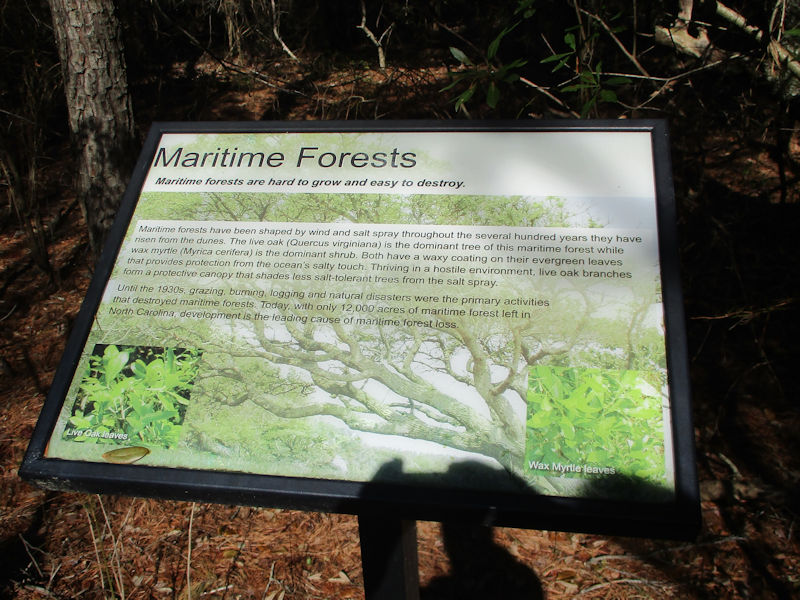
'Live oak', it turns out they're called, aka Quercus virginiana.

Are these weird, or what? About the name of the Reserve, 'Currituck', apparently derived from a Native American word for 'land of wild geese' [which had mostly been killed off in the 19th century], Currituck County includes both sides, the mainland and the outer banks, of the Currituck Sound.
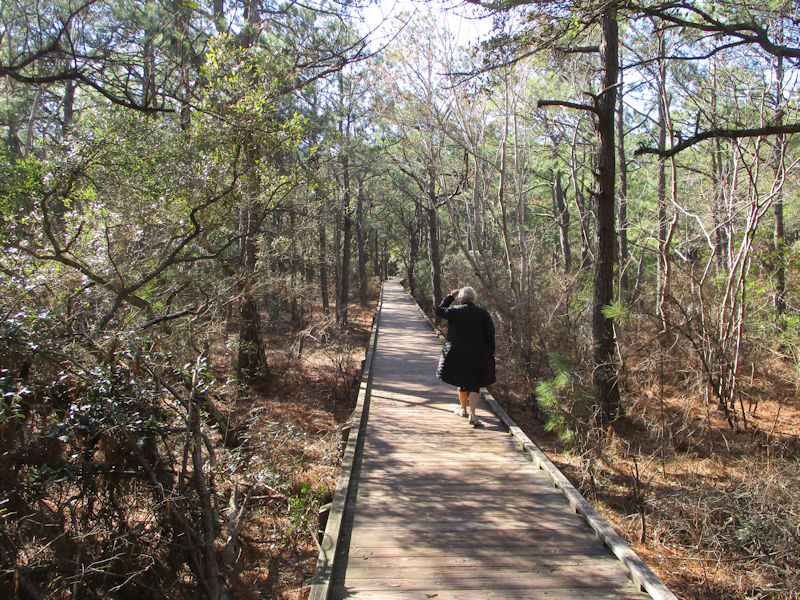
Nearly straight as an arrow . . .
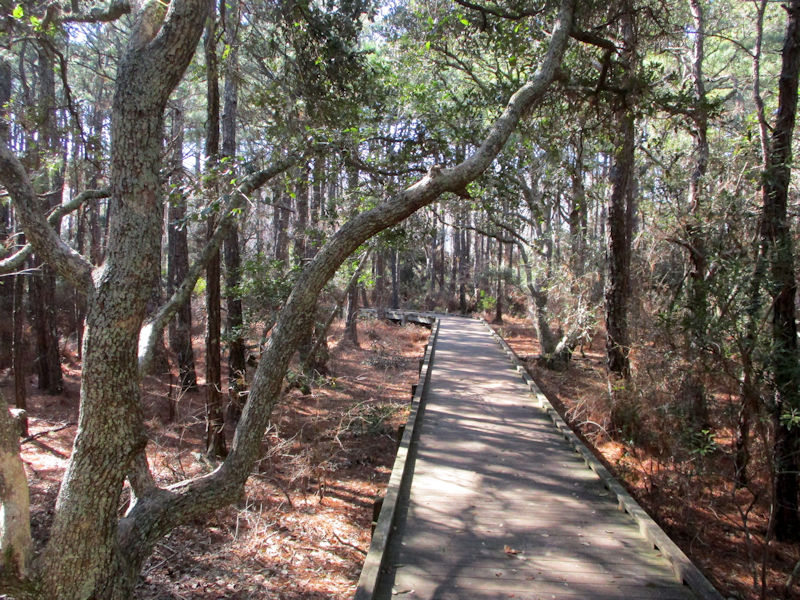
. . . with a little bend from time to time. A few birds overheard in the trees, otherwise no wildlife so far, not even the 'feral horses'.

Nearly there, wherever 'there' is.

-- Stay on the boardwalk; don't go wandering off on your own.
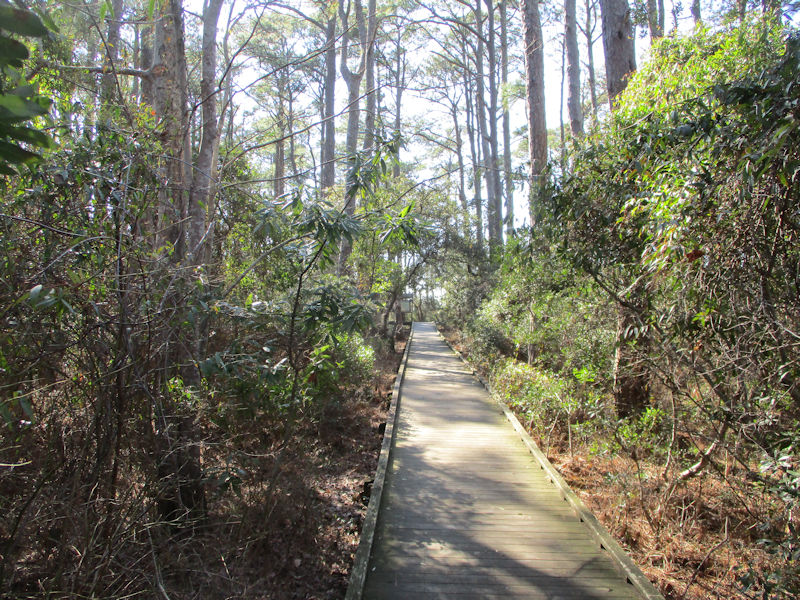
We're apparently running out of maritime forest. More and more 'wax myrtle' shrubs.
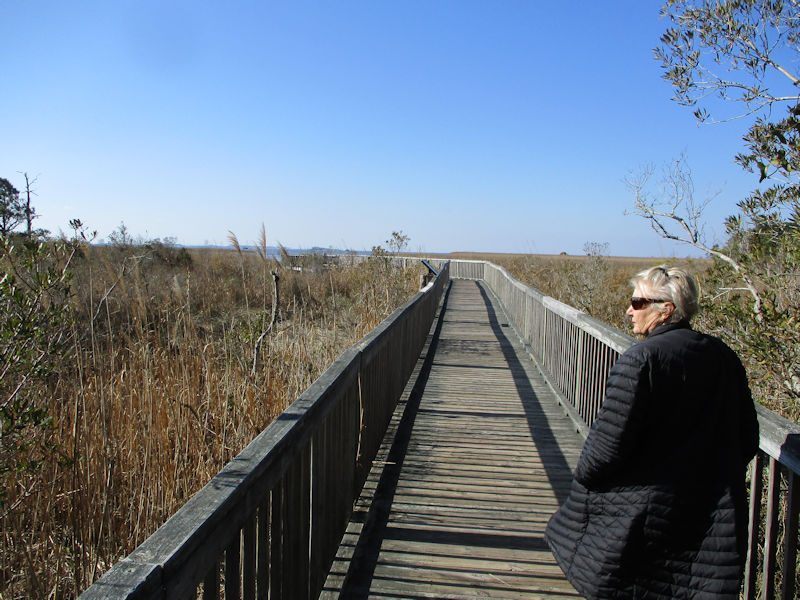

A proper estuary before us, stretching out to the sound
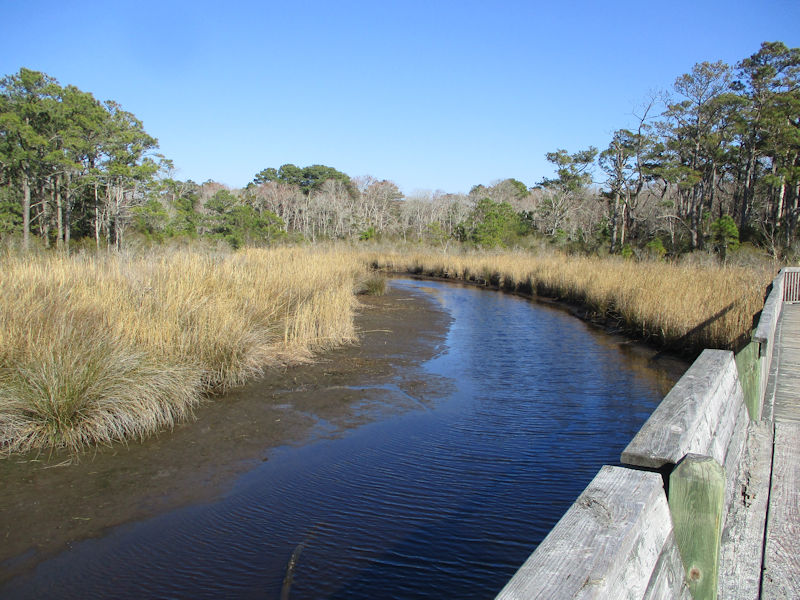
An estuary it may be, but an estuary coming from where? The whole landmass is only a kilometre wide at this point; what's the catchment?
It turns out, from the informative plaques along the way, that the estuary is the entire Currituck Sound, not just this pathetic drainage ditch. An estuary, we're told, is 'a place where fresh and salt waters meet and mix. Estuaries are important nursery areas for fishes and shellfishes.' This whole stretch is part of the National Estuarine Research Reserve System.
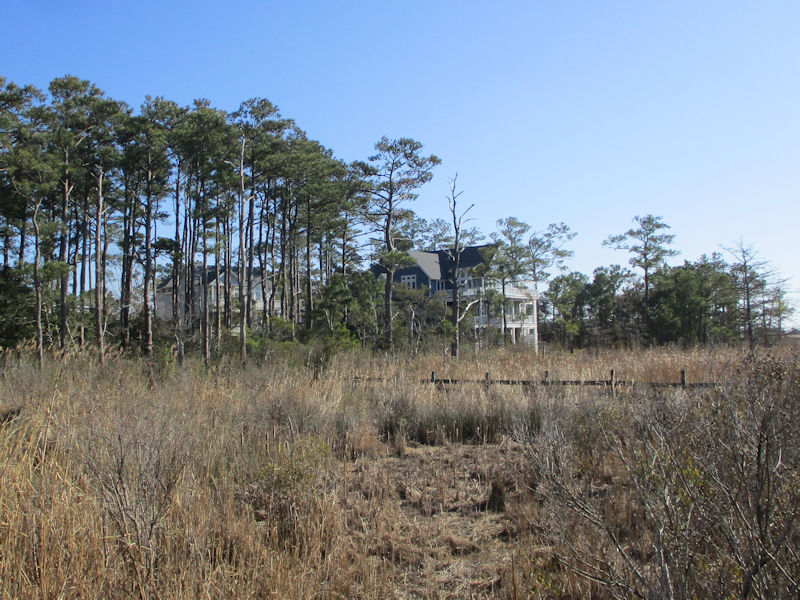
The neighbors (they'd be building right here on top of us if they were allowed to)

Back we go to the roadway, desperate to see some of the fabled 'wild horses'.

Weird trees everywhere. It must be awkward here on a windy night, with these things waving their arms all over the place in the dark.

Beach houses along the last length of Rte NC-12, all wisely built more or less on stilts.

It's like a beach-house parade. We've been provided with another handy boardwalk for our 650m trudge up the road to see the feral beasts.

One can see room for large differences in people's reactions to these things (not very well built, we're informed by a knowledgeable companion), but some of us can also easily be overcome with admiration for the general architectural style, not very varied for mile after mile of shoreline, but still . . . (perhaps from early memories of Seaside Heights, New Jersey).

We're almost to the end of the road, tiring of the scenery a bit, to be honest.

We really have no idea how many of these things are corporately owned establishments with flats for families and groups and so on, or privately owned places (like ours) for families and groups and so on, or the privately-owned second homes of outrageously rich families that have many many insistent friends and relatives.

The local guidebook, however, says that most of the buildings all along the length of the Outer Banks shoreline are built and operated by companies packing them in like cordwood during the high season. Some of the larger 'developments' do display only a handful of floor plans alternating along the little traffic circles.

This is the end of the public road for normal citizens like us, and the pavement ends in a little turnaround just beyond that car up the way a bit. This whole 49 km2 stretch is a animal sanctuary dedicated to wild horses ('feral Banker horses', we've read in one place, and 'wild colonial Spanish mustangs' we've read in another), and according to Wikipedia, 'over 50,000 people come to see them every week during the summer'. (That's actually a little hard to visualize; jostling shoulder to shoulder; sweating; irritable.)
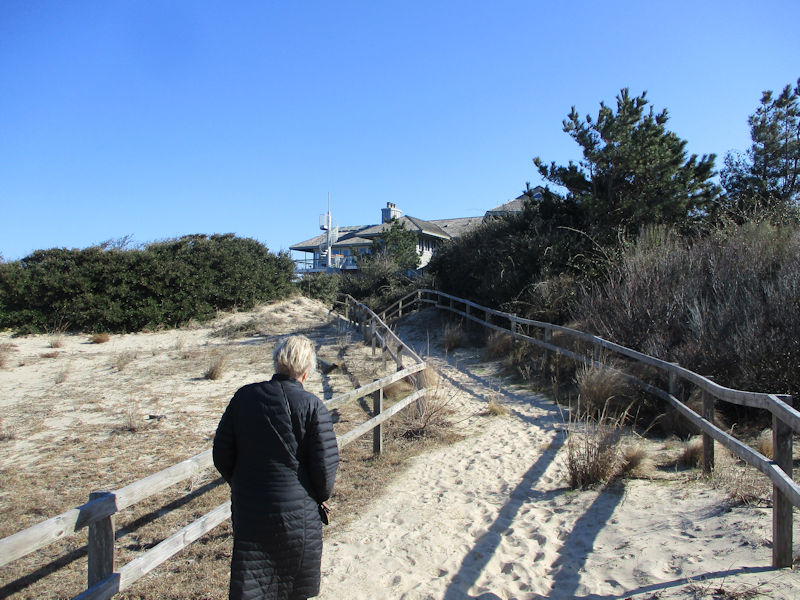
Our harmless little Volvo is unwelcome past that barrier (with that ominous depth gauge just next to the roadway), but we casual walkers won't be turned away.

Arid enough, surely, and sufficiently bleak. But we can't resist comparing this sandy expanse of shoreline to the Grand Sable Banks in Upper Michigan, to be seen here.
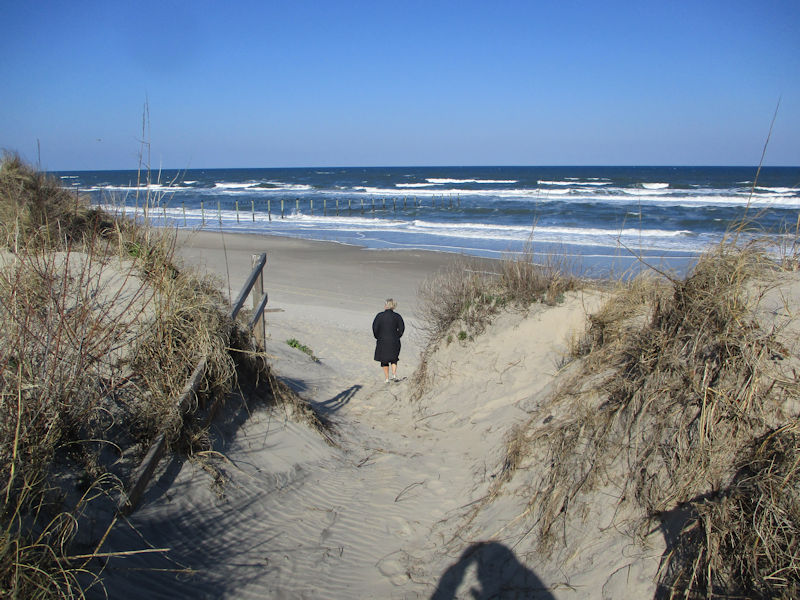
Our first glimpse of the Atlantic Ocean, on this trip anyway

We're starting north . . . towards Virginia.

No normal cars past this point. 4x4s, however, like these, whether privately owned, hired for the occasion, or driven by a guide, can proceed indefinitely up the shore.

It's called the 'N Beach Access Road' but it's really just a beach. It continues on the bare sand tracks for 2 miles before vacation accommodations resume, then (still driving on sand, with 'feral horses' still wandering all over) another 2 miles before leaving the 'Corolla' conurbation, another length of empty beach, backed all the way on the Sound side by the Currituck Banks Estuarine Reserve and the Currituck National Wildlife Refuge, before meeting up with the vacation homes and sand-pounded road grid of Carova Beach, and then entering Virginia, with 20 more miles of just sand up to Virginia Beach, where paved roads are once again preferred. (That's why 4x4 vehicles so practical here.)

A retirement home for aging cormorants

A glance southward towards downtown historic Corolla. BTW, Carova Beach was meant to be the developers' first big success on the North Banks when they laid out a subdivision street grid for ca.2,000 lots in 1967, but somebody snuck the Back Bay National Wildlife Refuge in to the north of it and closed off vehicular traffic except by permit. So eventually Corolla got its paved road from the south (and Carova got 4x4 access on sand).

We can't linger, we've got some serious shopping to do for the week's stay.
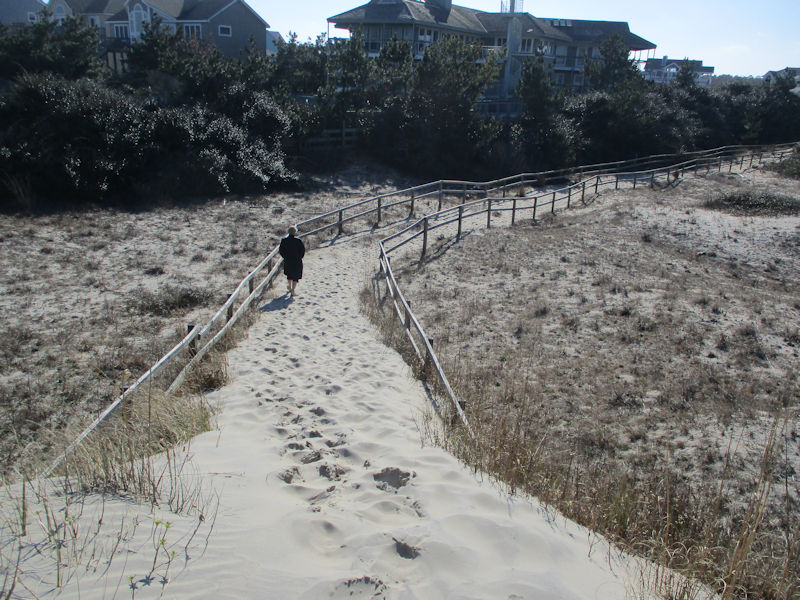
They're right, our little Volvo, however worthy a vehicle she might be, could never have managed this.

We're here at the Food Lion in the Monterey Plaza mall, just 3 or 4 miles south of the historic village, nice and clean, nearly empty of clients, and meeting all of our week's stocking up needs.
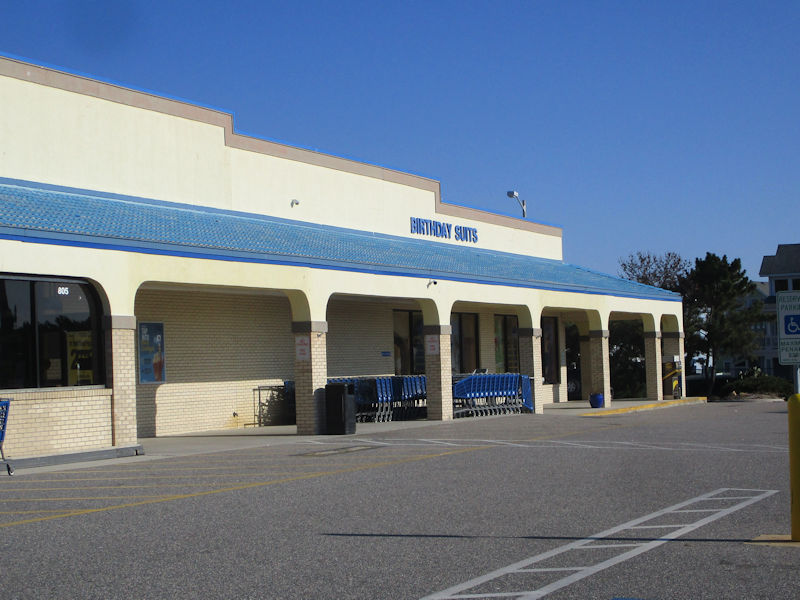
It's alongside a shop that sells 'birthday suits', apparently, and across the street from the Corolla Nail Lounge, a bright yellow franchise of the local Super Wings beach clothing chain, and the Timbuck II Shopping Village, including a generous cluster of restaurants, only one of which we could find that was open (a small Japanese restaurant with five tables). [Nos culpae, on our last night we found the excellent (but noisy) North Banks Restaurant & Raw Bar, which may have been open, unnoticed, all week.]
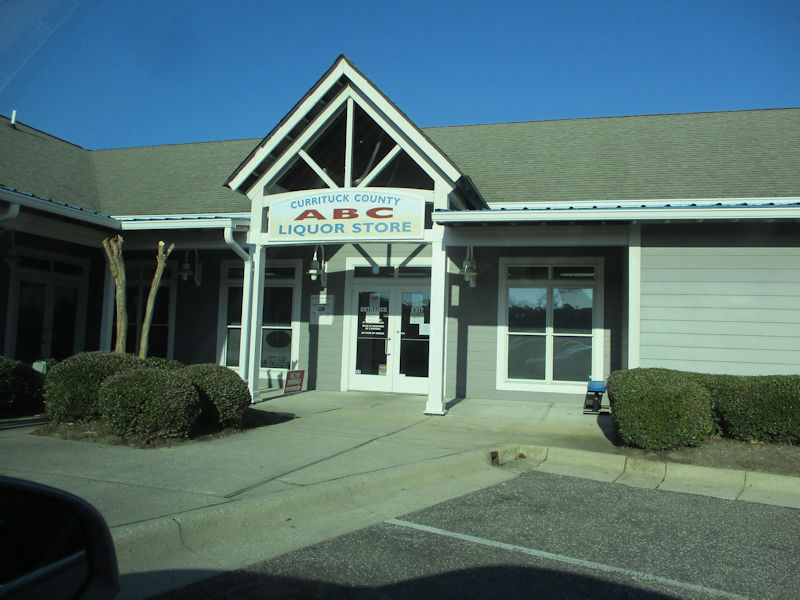
And here's what turned up just 3 miles and a bit down the road; it appeared that we'd be set for a while, but alas they didn't carry the required brand. They did, however, point us to the Metropolis tapas restaurant just across the road, which was extremely good (though a bit expensive) and unfortunately soon to be closing for the rest of our week in town.

We're expected, and they do appear to be settling in nicely.

Only Choupette could have got herself stuck in the grocery bag.
What's next, then? A march through the Nature Conservancy's Nags Head Woods Preserve,
with more very weird trees
 Dwight Peck's personal website
Dwight Peck's personal website






















































